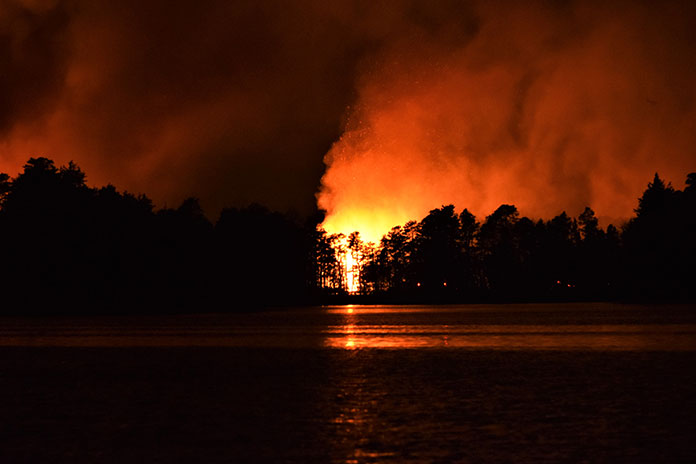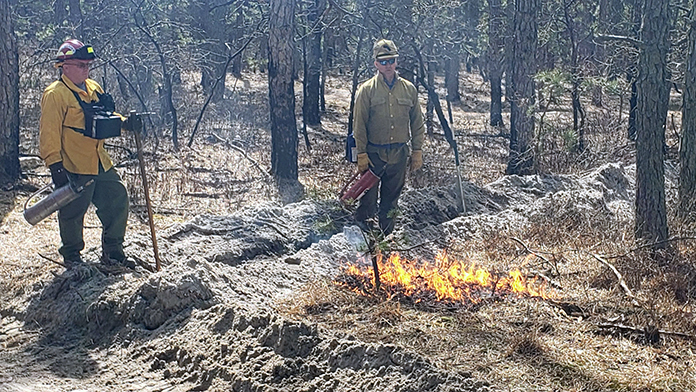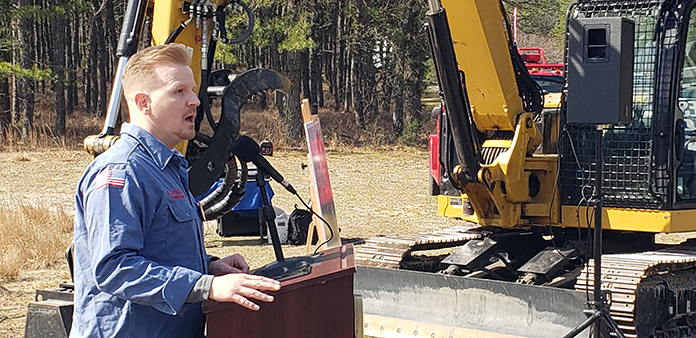
That event was on the minds of members of the New Jersey Department of Environmental Protection Forest Fire Service who joined representatives of Joint Base McGuire-Dix-Lakehurst and guests at a recent event when they promoted their alliance to combat wildfires in the area.
Part of this event was a prescribed burn demonstration. A prescribed burn is when Forest Fire Services staff burn away forest debris in a controlled manner so that the debris won’t be around to fuel the next forest fire. It is also used to maintain the effectiveness of fuel breaks. These are strips of land where vegetation has been cleared out or changed so that a forest fire has a stopping point.
The recently constructed Roosevelt City fuel break located near 1801 Harry Wright Boulevard and the base serves as an example of a partnership between the Forest Fire Service and Department of Defense to protect communities near military bases in the wildfire-prone Pinelands.
DEP Commissioner Shawn M. LaTourette and John Cecil, Assistant Commissioner for State Parks, Forests & Historic Sites, and DEP Administrator for Forests and Natural Lands Greg McLaughlin explained how the U.S. Department of Defense’s Readiness and Environmental Protection Integration (REPI) Challenge Program is using climate science and strong planning to better protect communities near military bases.

In 2018, the Ocean County Parks Department crafted a stewardship plan that called for a reduction of forest fuels around the area of Roosevelt City forming the fuel break which is now completed.
LaTourette remarked, “we are at the start of the spring fire season and that may bring back some scary memories for many folks throughout the state of New Jersey and it is because last year a number of homes were threatened by 14 major wildfires in the state.”
“Fortunately, thanks to our partnership, with the Department of Defense and local and county government including here in Manchester and with the county of Ocean, DEP and Forest Fire Service are taking steps to mitigate the threat of wildfires through projects like this,” he added.
Noting the REPI, LaTourette said they “build long term partnerships to improve resilience to climate change, preserve habitats and promote sustainable land management practices near military installations and ranges. Through that important partnership the DEP has received over $3 million in grants from the REPI program with $1.7 million of that in support of wildfire resilience projects.”
LaTourette said those projects include the Warren Grove fire break in Bass River State Forest, and the Greenwood Triangle Forest Fuel Maintenance project that is in Brendan Byrne State Forest.
He added that fuel breaks like the one in Roosevelt City “ensure the safety of our residents and the protection of our property as we confront increasing risks of wildfire. A fuel break is a man-made change in forest fuel characteristics which effect fire behavior. Fires within fuel breaks can be more readily controlled.”

LaTourette stressed that “it has become increasingly apparent that the need for continued attention and investment in this important work has to remain a top priority” at each level of government. “New Jersey is ground zero for some of the worst impacts of climate change.”
“Those impacts include a lengthening wildfire season. Sometimes I think we should start thinking about it as a wildfire year,” LaTourette added. “We had nearly 1,200 wildfires last year and 14 of them major, burning 18,000 acres. That is considerable risk to people, to property, to public health and safety and to the environment that we share.” He also noted increasing periods of dryness and drought “with periods of intense and fierce rainfall that punish our communities that are underprepared due to aging infrastructure and the ability of our resources to absorb, fast and intense flash flooding.”

Councilman Joseph Hankins, who has an extensive background in firefighting and was on the scene during last year’s wildfire, told The Manchester Times, “As a municipality we do what we can to mow the sides of the roads in the event you have wheel barring or a catalytic converter that become hot and start a fire on the edge of the road.”
“Without the assistance of the State Forest Fire Service and the County to mitigate the actual forest, we would lose the ability to at least slow down a forest fire in the event it happens. We’ve seen the catastrophes that have happened in California and in Texas most recently,” he added.
Hankins said the day’s event brought home, “the importance of making sure that we cover the residents out here in Whiting and make sure they are as safe as possible. This is a good step in doing that,” Hankins said.






